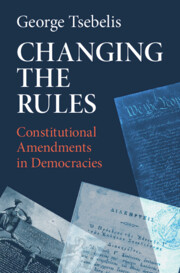Figures
2.2Change of core in one dimension under five-sevenths and six-sevenths majority
2.3Core of a unicameral legislature under qualified majorities and lack of core under simple majority
2.5Constitutional core with two-thirds majority in both chambers and a majority of states (Mexico)
2.7Large core produces smaller win-set, no matter where the status quo (SQ) is
3.1New constitutions do not come with new levels of constitutional rigidity
3.2Summary of the number of countries that changed their constitution and the difference in rigidity scores
3.3Correlations between amendment frequencies and the World Values Survey (WVS) and V-Dem Variables (variables used by Blake et al. [2023] in bold)
4.2Constitutional core of Chile, three-fifths, and president
4.3Constitutional core of Chile and two-thirds without president
5.1House and Senate support for constitutional amendments in Mexico from 2000 to 2013 by topic, coalition, and number of articles affected
5.2Congressional support for constitutional amendments in Mexico from 2000 to 2013
6.2The effect of constitutional rigidity on the rate of all amendments (amendments of constitutions in effect in 2013 in all democratic countries)
6.A.1.1The effect of constitutional rigidity on the rate of fundamental amendments (amendments of constitutions in effect in 2013 in all democratic countries)
6.A.1.2The effect of constitutional rigidity on the rate of significant and fundamental amendments (amendments of constitutions in effect in 2013 in all democratic countries)
8.1Legislative core: the court can make any statutory interpretation inside it
8.2Constitutional core larger than legislative core: any constitutional interpretation within the constitutional core stands
8.3Low constitutional rigidity is a necessary condition for low judicial independence
8.4The win-set of the status quo subject to constraints on judicial decision-making
8.5The win-set of the status quo subject to constraints on judicial decision-making, with uncertainty

